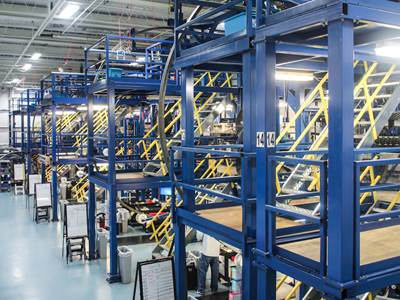The power of personal connections
CW columnist and IACMI chief commercialization officer Dale Brosius suggests that composites industry “old-timers” need to figure out a better way to connect to the generations that are entering the composites workforce.
There’s a classic line out there in cinema, that goes something like, “Hey, I know this guy who knows a guy....” It’s usually uttered when the speaker is helping someone out of a predicament, and is often associated with something illegal, or at least embarrassing. There’s another line: “It’s not what you know, but who you know.” This adage implies that it’s more important to be connected than it is to be competent.
It’s unfortunate that the above lines have negative connotations. Although I believe competence is essential to doing a good job, knowing where to go when you need an answer or have a thorny problem to solve, is critical. For the most complicated of problems, knowing someone who can help, or knowing someone who knows someone who can help, makes us all more valuable to our organizations and our customers. While our internal colleagues are often good resources, going outside to get additional perspectives or specialized knowledge can accelerate the solution-finding process and can result in a better solution. In a global world, where the right answer may lie halfway across the planet, one of the most valuable assets any of us can possess is a strong professional network. This is as important in the world of composites as in any industry.
I personally am fortunate to be connected to a large number of people within the composites industry across a number of countries. I have worked for companies that required (or better, allowed) me to travel extensively across the US and internationally, and to work in Europe for almost two years in a role that entailed significant travel. I have amassed many contacts over the years — and have boxes of business cards to show for it.
I realize not everyone gets such an opportunity. But there are other routes to connectivity. At least as significant in terms of impact on my network has been my participation in professional societies, in particular the Society of Plastics Engineers (SPE, Bethel, CT, US) and the Society for the Advancement of Material and Process Engineering (SAMPE, Covina, CA, US). Any of us can take advantage of what these societies offer — local, national and international scientific conferences, exhibitions and networking platforms — simply by signing up as a member and attending. But the real benefits come from participating in this kind of organization at a deeper level, by presenting at conferences, or serving as a session chair, on a conference committee or as a board member. These activities have served me very well.
Despite the value such organizations provide, membership in professional societies globally has declined substantially over the past decade, and the average age of members has increased. Clearly, young engineers and scientists are not joining at the rate previous generations have done. Several theories have been proposed to explain this decline, including that, in the interest of cost reduction, companies have been less willing to pay the annual membership dues, and that younger professionals rely extensively on social media to interact with others. I, too, use tools such as LinkedIn and Twitter, but they are poor substitutes for face-to-face and telephone interaction when looking for an answer or a solution.
The Internet, on the whole, has contributed to our ability to “self-diagnose” many problems, including those involving scientific questions, or to find suppliers of particular products or solutions, and some would argue that a strong network is not as important as it used to be. Until, of course, it is important. Although there are dozens of Web sites that provide medical advice, we don’t trust ourselves to perform our own surgery! Sometimes, external expertise and training are — literally — just what the doctor ordered.
It’s also clear that we “old-timers” need to figure out a better way to connect to the generations that are now entering the workforce and will enter it in the coming decade. The implications for the future of the composites industry are significant. As I write this, we just finished our Institute for Advanced Composites Manufacturing Innovation (IACMI, Knoxville, TN, US) summer members meeting. In addition to industry representatives and professionals from our university and national laboratory partners, we invited, and had extensive interaction with, graduate and undergraduate student interns, as well as several high school students. These “in-person” activities will — I hope — demonstrate the value of building networks the old-fashioned way.
We plan to expand this, and I know that SPE and SAMPE are pursuing similar initiatives. Many of us have championed replacement of traditional materials and processes with composite solutions for decades. Those of us who maintain a vision of composites becoming as ubiquitous as steel or concrete will need these next generations to pick up that torch and continue running with it, building connections the way we have — face to face.
Related Content
Infinite Composites: Type V tanks for space, hydrogen, automotive and more
After a decade of proving its linerless, weight-saving composite tanks with NASA and more than 30 aerospace companies, this CryoSphere pioneer is scaling for growth in commercial space and sustainable transportation on Earth.
Read MorePlant tour: Joby Aviation, Marina, Calif., U.S.
As the advanced air mobility market begins to take shape, market leader Joby Aviation works to industrialize composites manufacturing for its first-generation, composites-intensive, all-electric air taxi.
Read MoreThermoplastic composites: Cracking the horizontal body panel nut
Versatile sandwich panel technology solves decades-long exterior automotive challenge.
Read MoreNovel dry tape for liquid molded composites
MTorres seeks to enable next-gen aircraft and open new markets for composites with low-cost, high-permeability tapes and versatile, high-speed production lines.
Read MoreRead Next
Modeling and characterization of crushable composite structures
How the predictive tool “CZone” is applied to simulate the axial crushing response of composites, providing valuable insights into their use for motorsport applications.
Read MoreVIDEO: High-rate composites production for aerospace
Westlake Epoxy’s process on display at CAMX 2024 reduces cycle time from hours to just 15 minutes.
Read MorePlant tour: A&P, Cincinnati, OH
A&P has made a name for itself as a braider, but the depth and breadth of its technical aptitude comes into sharp focus with a peek behind usually closed doors.
Read More










.jpg;maxWidth=300;quality=90)










